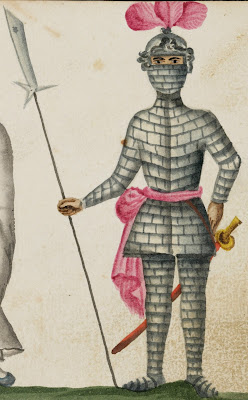Myth 1. Rattan shield is bulletproof.
 |
| A Chinese rattan shield, late Qing (Boxer rebellion) period. (Source: Zemanek-Münster) |
Ming period military writers such as Qi Ji Guang (戚繼光) explicitly stated that rattan shield won't protect its user against arquebus rounds. There were, however, attempts to make rattan shield bulletproof by reinforcing the shield with cotton blanket, even though these attempts most likely resulted in failure (see my second point).
Myth 2. Cotton armour is bulletproof.
 |
| Late Joseon Dynasty cotton armour known as Myeonje Baegap (면제배갑 or 綿製背甲), designed to withstand not just arquebuses and muskets, but modern rifles such as Remington Rolling Block rifle. (Source: The Metropolitan Museum of Art) |
Nevertheless, actual effectiveness of cotton armour was disputed even during Ming period. Song Ying Chang (宋應昌) once experimented with the effectiveness of soaked cotton blanket against Japanese matchlock gun, and concluded that a Japanese arquebus could pierce two soaked cotton blankets from eighty paces (i.e. about 420 feet or 128 metre) away, and three to four layers from fifty paces (i.e. about 262.5 feet or 80 metre) away.
Qi Ji Guang also designed a composite shield known as Gang Rou Pai (剛柔牌), which was said to be superior to normal cotton blanket. Yet even his superior design could only stop an arquebus round from about forty paces (i.e. about 210 feet or 64 metre) away at the closest. Nevertheless, Qi Ji Guang considered this safe distance good enough for his troops.
Myth 3. Koxinga's Tie Ren (鐵人) wore bulletproof iron armours.
 |
| A Chinese warrior, most probably a Tie Ren, in a full suit of metal armour. He is wielding what appears to be a Zhan Ma Dao (斬馬刀). From 'Georg Franz Müller von Ruffach Reise nach Batavia', 1681. |
— Dutch Formosa governor Frederick Coyett, in his book titled Neglected Formosa ('t Verwaerloosde Formosa).
This myth probably stem from above quote, however the "rifle bullet" is actually a mistranslation of the Dutch "zijdegeweer". Correct translation of the word should be "side-arm", referring to a type of sword or sabre commonly carried by Dutch troops of the time.
Myth 4. Koxinga never fielded arquebusiers/musketeers.
『時鄭兵前隊長鎗,次團牌;第二陣倭銃。』
"At the time (Battle of Zhenjiang), Zheng troops' forward platoon used pikes, mixed with round shields. Second formation (consisted of) arquebusiers with Japanese guns."
— Early Qing period historian Ji Liu Qi (計六奇), in his book 'Ming Ji Nan Jue (《明季南略》)'.
Owing to his good relationship with Japan (Koxinga was half Japanese), Koxinga had better access to high quality matchlock guns than many of his contemporaries (however by that time Vietnamese matchlock had surpassed Japanese matchlock in quality, range and firepower, so Koxinga did not have decisive advantage). During his conquest of Formosa (present-day Taiwan), he also employed so-called "Black Boys", or ex-black slaves, as musketeers.
Myth 5. Chinese lost the knowledge to manufacture Han Dynasty-style crossbow mechanism during Ming period.
They didn't.
While Ming Chinese did switch to a type of inferior, deer antler crossbow trigger, they probably did so out of economic consideration, as crossbow was rendered obsolete by firearms. Han Dynasty-style crossbow trigger had fallen out of use, but never completely forgotten.


https://s-media-cache-ak0.pinimg.com/736x/eb/2c/4a/eb2c4af690346e7ff6ca4af655bcbab1.jpg
ReplyDeleteIs this a picture of tie ren?
No, this is a unhistorical movie prop.
Deletehttps://s-media-cache-ak0.pinimg.com/736x/2d/41/b8/2d41b8898767355332ed2ee2f6fe3871.jpg
ReplyDeletethan this is a real thing?
possibly tie ren armor?
No, that's probably a fake as well.
DeleteHey, this is probably a weird place to post this but I just wanted to say thank you for this site. It's been really interesting and useful for me since it seems like the only alternative has been Swope or something. I appreciate your balanced/critical approach to all the sources you draw upon.
ReplyDeleteAlso, I was wondering--are you RollingWave from TWC/Historum/Samurai forums etc.,? Have you also posted on 4chan's /his/ before?
@Bleb
DeleteHello and welcome to my blog!
No, I am not RollingWave, as I don't participate in forum discussion. I do not play Total War games (except RomeTW 1, briefly), and have never been to 4chan.
Unrelated, but there is source said that Konxiga charge toward European castle/fort.
ReplyDeleteWhy does Konxiga charge toward their castle? Is Ming Chinese castle so fragile that a frontal charge can bring it down?
It probably means "storm the castle"?
DeleteI blame the myth no.1 to the Romance of the Three Kingdoms, which exaggerated rattan armor like something made out of Kevlar.
ReplyDelete